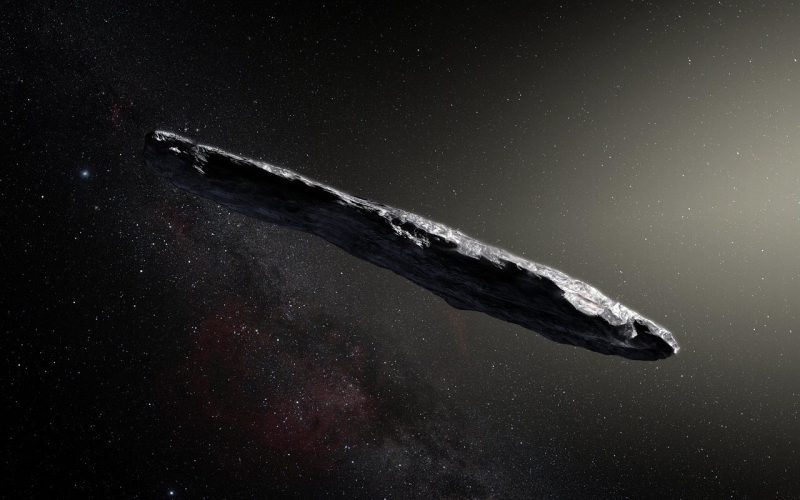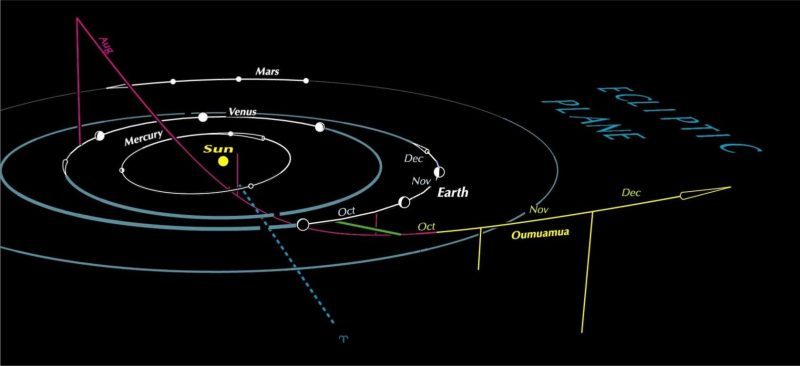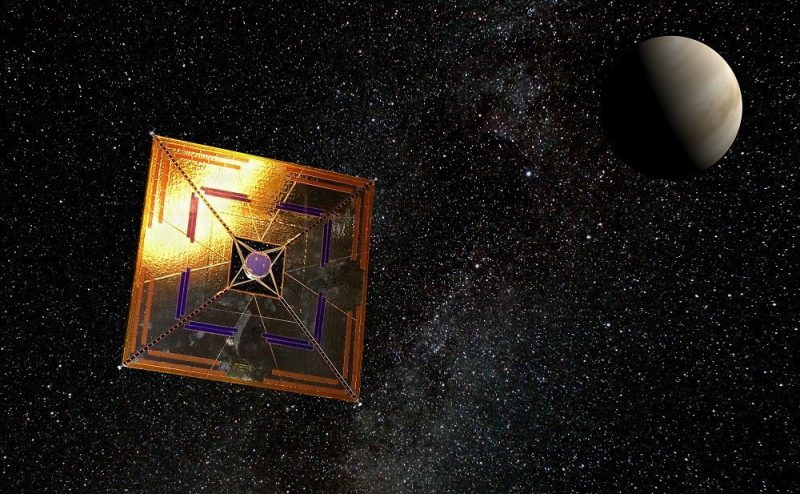
When the object now known as ‘Oumuamua was first discovered a year ago, it caught astronomers by surprise. It’s an oddly elongated, tumbling object whose orbit indicated it came from outside our solar system. Although interstellar objects – natural objects like comets or asteroids that move between solar systems – had been expected, no object like this one had been seen before. So what was it? Scientists and others immediately began speculating and devising theories. Asteroid? Comet? Shard of a destroyed planet? On November 1, 2018, a new paper was released that raises again the possibility that ‘Oumuamua might be artificial – something like a lightsail or solar sail, a spacecraft whose propulsion method is the radiation pressure or “wind” from stars.
Shmuel Bialy and Abraham Loeb at Harvard Smithsonian Center for Astrophysics are co-authors on the new paper (preprint here).
The 2019 lunar calendars are here! Order yours before they’re gone. Makes a great gift.

When ‘Oumuamua swept through our solar system in late 2017, it was moving quickly. There was limited time to observe it with telescopes before it rounded our sun and then left our solar system again. Being small and far away, even at closest approach to our sun, didn’t help matters either.
Astronomers did learn that ‘Oumuamua was an oddball. Its trajectory told astronomers it had originated from outside the solar system, but its shape, as best as could be determined, didn’t match that of most known asteroids or comets. Still, at first, scientists thought it was an asteroid. Then, by northern summer of 2018, scientists leaned more toward it being a comet. But, if it were a comet, why didn’t ‘Oumuamua show outgassing – i.e., a characteristic cometary coma or tail – when it was closest to the sun? A study by Roman Rafikov, an astrophysicist at the University of Cambridge, showed that the forces that should have produced a tail should also have affected the object’s spin, but they did not.
That’s when the idea arose that ‘Oumuamua might not be an asteroid or a comet, but rather a “shard” from a planet destroyed by a white dwarf star. As noted in Quanta Magazine on October 10, 2018:
In particular, the acceleration would have torqued ‘Oumuamua to such a degree that it would have spun apart, breaking up into smaller pieces. If ‘Oumuamua were a comet … it would not have survived.
If it’s an asteroid, then it’s really unusual, with exotic scenarios for its formation. [Rafikov] proposed such a scenario earlier this year, whereby an ordinary star dies, forming a white dwarf, and in the process rips apart a planet and launches the shards clear across the galaxy.
‘Oumuamua is one of those shards. ‘Basically, it’s a messenger from a dead star,’ [Rafikov] said.
All along, some people speculated that ‘Oumuamua might not be a natural object, that it might instead be something artificial, sent to “check out” our inner solar system. Occam’s razor – where the simplest explanation is usually the correct one – supported the idea that it was probably a natural object, albeit an unusual one.

So ‘Oumuamua was unusual for its deduced shaped (it wasn’t able to be fully resolved with telescopes, however) and lack of outgassing when nearest the sun, as would have been expected from a comet. Plus, there was another feature of ‘Oumuamua that caught astronomers’ attention. Earlier this year, as it was heading back out of the solar system, it was observed to slightly accelerate in speed.
This acceleration was determined not to be caused by the gravitational influence of the sun or any planet in our solar system. It was a puzzle. Outgassing could do it, but no outgassing was ever observed, either. Also, outgassing would have affected the object’s spin, but that was not seen either, even though the object was tumbling, according to the limited observations.
The new paper suggests that solar radiation pressure – created by the momentum of photons coming from the sun – could instead be the cause of the increased speed. Sounds plausible, and this is where the story really gets interesting.
According to calculations, for radiation pressure to be the cause of the acceleration, ‘Oumuamua would need to be a thin object with a small mass-to-area ratio. It would need to be a thin sheet, roughly 0.01 inch (0.3 mm) thick and 65 feet (20 meters) in radius.
As Paul Gilster explained in an excellent post on Centauri-Dreams:
I was intrigued enough at this point to ask Dr. Loeb about those dimensions, which vary with albedo (the incident light reflected by a surface). He told me that the 20-meter figure would be the radius if the object is a perfect reflector, though the size would be larger if the value for the albedo is smaller. We do see variations in reflected light as ‘Oumuamua rotates over an eight-hour spin period. Thus, considering the object as a thin surface, we could imagine a conical or hollow cylindrical shape.
‘You can easily envision that by rotating a curved piece of paper and looking at its net surface area from different viewing angles,’ Loeb told me.

If the speed increase was caused by solar radiation pressure – and that isn’t known for sure yet – then the object would need to have a thin, sheet-like surface according to the researchers. That’s where lightsails come in, which are already being tested by NASA and other space agencies as a method of propulsion throughout the solar system – using a giant thin “sail” to collect photons from the sun and create momentum. From the new paper:
Considering an artificial origin, one possibility is a lightsail floating in interstellar space as debris from an advanced technological equipment (Loeb 2018). Lightsails with similar dimensions have been designed and constructed by our own civilization, including the IKAROS project and the Starshot initiative. The lightsail technology might be abundantly used for transportation of cargos between planets (Guillochon and Loeb 2015) or between stars (Lingam and Loeb 2017). In the former case, dynamical ejection from a planetary system could result in space debris of equipment that is not operational any more (Loeb 2018) and is floating at the characteristic speed of stars relative to each other in the Solar neighborhood.
The new paper has caused a lot of speculation and debate! Unfortunately, ‘Oumuamua itself can’t serve as a source of further answers; it is now too far away for any additional observations. The best hope now is that another similar object will be found in the near future.
Applying Occam’s razor, it is still most likely that ‘Oumuamua is a natural, yet very unusual object, based on the limited data available.
However, if the solar radiation pressure idea could be confirmed somehow, that would make things very interesting indeed.

Want more about this idea? The results were initially discussed in Paul Gilster’s post at Centauri-Dreams.org on October 29, 2018.
See also the Micheli et al. paper: Non-gravitational acceleration in the trajectory of 1I/2017 U1 (‘Oumuamua).
See the Trilling et al. paper: Spitzer observations of ‘Oumuamua and ‘Oumuamua’s density and shape.
And see the Mamajek paper: Kinematics of the Interstellar Vagabond 1I/’Oumuamua (A/2017 U1).
Lastly, because life does sometimes imitate art, look for the definitive work of science fiction related to the idea of interstellar objects sweeping through our solar system, by British writer Arthur C. Clarke. The book is “Rendezvous with Rama,” first published in 1973.
Bottom line: ‘Oumuamua was the first interstellar object observed to enter our solar system, and it brought with it many questions. Unfortunately, most of those questions will probably remain unanswered, since ‘Oumuamua is now too far away for additional observations.
Source: Could Solar Radiation Pressure Explain ‘Oumuamua’s Peculiar Acceleration?











